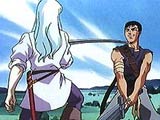

Quick Links:
Berserk
Based on the manga by Miura Kentaro, Berserk is set in a late medieval, low fantasy land ruled by fate. The saga begins with a tall, cloaked man bearing an oversized sword who trounces a band of warriors, letting one live to tell his liege that the Black Knight has come. This Black Knight is Gatts, bound to some dark spirits by a rune tattoo, yet on a quest to destroy the corrupt lord of this dark land...
As in Record of Lodoss War, following this first episode are a series of flashbacks, relating the background of Gatts and this new king of the land, Griffith (Gurifis). The early plot details the rise of Gatts and Griffith to power and prestige as leaders in Griffith’s mercenary cadre, the Band of Hawks. As in Heroic Legend of Arislan, the battles are spiced up by the clever tactics used by the Band of Hawks in defeating its enemies, though few of the tactics are as ingenious or memorable as those introduced in Arislan or Braveheart. There is a good bit of foreshadowing about the mysteries of who Griffith is and what his Red Behelit is, leaving us also to wonder about the origins of the dark tattoo which tormented Gatts in the first episode. In terms of magic / fantasy elements, Berserk solely has demons or gods which appear but rarely, leaving the majority of the world governed by the mundane, as in Heroic Legend of Arislan.
Just as the plot of Berserk follows the standard medieval war archetype, so do the characters fall into the traditional mercenary archetypes. Gatts is a taciturn, stubborn blade master who has become Griffith’s new right-hand man; Caska is Griffith’s second-in-command who resents Griffith’s favoritism of this impetuous new soldier but subordinates her emotions to her duty to maintain order among the mercenaries; Corkus is a jealous squad leader who wants revenge on Gatts for slaying a friend of his, and so forth. Griffith is more mysterious than these stereotypes--he is a charismatic leader and skilled tactician, but he also has the mysterious Red Behelit, the Egg of Kings, as well as strength and speed which are able to outclass Gatts even though Griffith uses a much smaller blade. He resents the foolishness of aristocrats and yet strives for rulership of his own, reminding the viewer of the dark, nightmarish land ruled by a king Griffith from the first episode. In terms of art style, Gatts looks a lot like Ninja Master Gara of Bastard wielding Sanosuke’s (of Rurouni Kenshin) sword, while Griffith loosely resembles Arislan of Heroic Legend of Arislan wielding a slender saber.
The animation in Berserk is extremely dated. The animators use every trick possible to reduce the number and detail of frames, feeling no qualms about zooming in on boots for when Gatts is running or shifting the camera around stills to the neglect of animating character movement. On a positive note, there are not many recycled frames, and there's an excessive amount of Vandal Hearts-esque blood gushing forth from the numerous newly dead during the combat scenes, adding to the amusement factor. Expect more blood than animation and you won’t be disappointed ^_^
The music for Berserk complements the war theme with an interesting mix of acoustic rock and Enigma-esque singing. During battle scenes the music takes on a Celtic flavor, while in other places the eerie singing enhances the emotive impact of certain scenes. Surprisingly enough, both the introductory and closing songs are rock songs sung in English, rounding off the variety of music accompanying the anime. The orchestration may not be of Escaflowne or Macross Plus quality, but it is still quite memorable and definitely above average.
Overall, Berserk is just an older variant of the fantasy war genre of anime. Both characters and plot are fairly run-of-the-mill, and the battle ingenuity is less memorable than that of Heroic Legend of Arislan or Braveheart, limiting its appeal to fans of the genre. If you enjoy watching the bloody war saga of a barbarian seeking a reason to live, and are willing to put up with the stereotypes and dated animation, Berserk can be a very enjoyable experience. Otherwise, it is likely to disappoint.
For reference, this review is based solely on the first 8 out of 25 episodes.
Distributor: Urban Vision Creator: Miura Kentaro, OLM Released: 1997
Plot: B Character Design: B Animation Quality: C- Music: B+ Overall: B-



